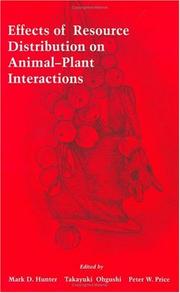| Listing 1 - 10 of 22 | << page >> |
Sort by
|
Book
ISBN: 9535110527 9535153595 Year: 2013 Publisher: IntechOpen
Abstract | Keywords | Export | Availability | Bookmark
 Loading...
Loading...Choose an application
- Reference Manager
- EndNote
- RefWorks (Direct export to RefWorks)
Studies of herbivory provide important insights into fundamental questions in many areas of the biological sciences. The focus on natural systems is more effective for the prediction of potential changes in ecosystems, given that agricultural systems are designed to create an equilibrium that optimizes the productive process. Given the ramifications of the processes related to herbivory, studies based on complementary approaches are necessary for a better understanding of the different aspects of the ecological process. This book attempts to expand on these different aspects of herbivory by presenting a multidisciplinary approach to a number of different themes, focusing on topics that range from basic research in natural habitats to the intrinsic relationships between animals and plants in agricultural systems.
Animal-plant relationships. --- Animal-plant interactions --- Animals and plants --- Interactions, Animal-plant --- Plant-animal interactions --- Plant-animal relationships --- Plants and animals --- Relationships, Animal-plant --- Ecology --- Animal behaviour
Book
ISBN: 9783030866884 Year: 2022 Publisher: Cham Springer International Publishing :Imprint: Springer
Abstract | Keywords | Export | Availability | Bookmark
 Loading...
Loading...Choose an application
- Reference Manager
- EndNote
- RefWorks (Direct export to RefWorks)

ISBN: 1283154676 9786613154675 064309315X 9780643093157 9781283154673 0643091580 9780643091580 0643099816 Year: 2005 Publisher: Collingwood, Vic. CSIRO Pub.
Abstract | Keywords | Export | Availability | Bookmark
 Loading...
Loading...Choose an application
- Reference Manager
- EndNote
- RefWorks (Direct export to RefWorks)
Explore a controversial theory that challenges the common understanding of natural population control in herbivores.
Population biology. --- Animal-plant relationships. --- Nitrogen in animal nutrition. --- Animal nutrition --- Animal-plant interactions --- Animals and plants --- Interactions, Animal-plant --- Plant-animal interactions --- Plant-animal relationships --- Plants and animals --- Relationships, Animal-plant --- Ecology --- Biology
Book
ISBN: 3030866874 3030866882 Year: 2022 Publisher: Cham, Switzerland : Springer,
Abstract | Keywords | Export | Availability | Bookmark
 Loading...
Loading...Choose an application
- Reference Manager
- EndNote
- RefWorks (Direct export to RefWorks)
Animal-plant relationships. --- Animal-plant interactions --- Animals and plants --- Interactions, Animal-plant --- Plant-animal interactions --- Plant-animal relationships --- Plants and animals --- Relationships, Animal-plant --- Ecology --- Lepidòpters --- Relacions animal-planta
Book
ISBN: 1282426591 9786612426599 0226327957 9780226327952 9780226327938 0226327930 9780226327945 0226327949 Year: 2009 Publisher: Chicago London The University of Chicago Press
Abstract | Keywords | Export | Availability | Bookmark
 Loading...
Loading...Choose an application
- Reference Manager
- EndNote
- RefWorks (Direct export to RefWorks)
"Plants produce a considerable number of structures of one kind, like leaves, flowers, fruits, and seeds, and this reiteration is a quintessential feature of the body plan of higher plants. But since not all structures of the same kind produced by a plant are identical[,] for instance, different branches on a plant may be male or female ..., a single plant genotype generally produces a multiplicity of phenotypic versions of the same organ. [This work] uses this subindividual variation to deepen our understanding of the ecological and evolutionary factors involved in plant-animal interactions. On one hand, phenotypic variation at the subindividual scale has diverse ecological implications for animals that eat plants. On the other hand, by choosing which plants to consume, these animals may constrain or modify plant ontogenetic patterns, developmental stability, and the extent to which feasible phenotypic variants are expressed by individuals. An innovative study of the ecology, morphology, and evolution of modular organisms, [this work] addresses ... the ways in which organisms have coevolved to cope with variable environments."--Rudolf Schmid in Taxon.
Plants --- Animal-plant relationships. --- Plant genetics. --- Genetics --- Animal-plant interactions --- Animals and plants --- Interactions, Animal-plant --- Plant-animal interactions --- Plant-animal relationships --- Plants and animals --- Relationships, Animal-plant --- Ecology --- Botany --- Plant species --- Plant variation --- Plant diversity --- Plant genetics --- Variation (Biology) --- Variation. --- Variation --- Animal-plant relationships --- 581.4 --- 581.4 Plant morphology. Plant anatomy --- Plant morphology. Plant anatomy
Book
ISBN: 1623496454 9781623496456 9781623496449 Year: 2018 Publisher: College Station
Abstract | Keywords | Export | Availability | Bookmark
 Loading...
Loading...Choose an application
- Reference Manager
- EndNote
- RefWorks (Direct export to RefWorks)
Flowers have played an important role in human culture for thousands of years, symbolizing love, sorrow, and renewal. They provide bursts of color to homes and gardens and convey messages to friends, family, and significant others. Yet we often overlook their real purpose--why do flowers exist and why are they certain colors, shapes, and smells? In nature, flowers are key to healthy ecosystems and play a functional role, increasing a plant's chances for survival. Flowers have evolved to attract specific pollinators and to take advantage of climate variables and animal migration to disperse seeds, ensuring that the species will survive. These fine-tuned methods have evolved over a long period of time, and the importance of pollination and seed dispersal to a healthy environment cannot be overstated. As climate change places pressure on animals and plants, it is also challenging these methods flowers have developed for survival. The Fogdens describe flowers' functions and structures, pollination and seed dispersal methods, and close the book with descriptions of their favorite tropical flowers. The information is illustrated with intimate photographs of flowers and pollinators.
Animal-plant relationships. --- Human-plant relationships. --- Flowers. --- Blooms (Flowers) --- Blossoms --- Flowering plants --- Inflorescences --- Plants --- Floral products --- Man and plants --- Man-plant relationships --- Plant-human relationships --- Plant-man relationships --- Plants and man --- Relationships, Human-plant --- Human beings --- Botany, Economic --- Ethnobotany --- Synanthropic plants --- Animal-plant interactions --- Animals and plants --- Interactions, Animal-plant --- Plant-animal interactions --- Plant-animal relationships --- Plants and animals --- Relationships, Animal-plant --- Ecology
Book
ISBN: 0198577540 Year: 1992 Volume: vol 46 Publisher: Oxford : Clarendon Press,
Abstract | Keywords | Export | Availability | Bookmark
 Loading...
Loading...Choose an application
- Reference Manager
- EndNote
- RefWorks (Direct export to RefWorks)
Animal-plant interactions --- Animal-plant relationships --- Animal-plante [Relations ] --- Animals and plants --- Benthos --- Biological oceanography --- Dier-plant relaties --- Ecologie [Mariene ] --- Ecologie marine --- Interactions [Animal-plant ] --- Mariene ecologie --- Marine ecology --- Plant-animal interactions --- Plant-animal relationships --- Plant-dier relaties --- Plante-Animal [Relations ] --- Plants and animals --- Relaties [Dier-plant ] --- Relations animal-plante --- Relations plante-animal --- Relationships [Animal-plant ] --- Zee--Ecologie --- Issue --- Benthal organisms --- Benthic organisms --- Benthonic organisms --- Bentos --- Benthos. --- Animal-plant relationships. --- Marine ecology. --- Animals. --- Animals --- Interactions --- Meetings --- Plants

ISBN: 0412439506 0412443902 9780412439506 9780412443909 Year: 1992 Publisher: London New York Tokyo Chapman & Hall
Abstract | Keywords | Export | Availability | Bookmark
 Loading...
Loading...Choose an application
- Reference Manager
- EndNote
- RefWorks (Direct export to RefWorks)
Forest ecology. --- Plant communities. --- Animal-plant relationships. --- Animal-plant relationships --- Forest ecology --- Plant communities --- #ABIB:abos --- 581.526.42 --- 581.526.42 Forest formations --- Forest formations --- Forests and forestry --- Ecology --- Animal-plant interactions --- Animals and plants --- Interactions, Animal-plant --- Plant-animal interactions --- Plant-animal relationships --- Plants and animals --- Relationships, Animal-plant --- Communities, Plant --- Phytosociology --- Plant associations --- Plant societies --- Biotic communities --- Plant ecology --- General ecology and biosociology --- Forestry --- Forest ecosystems
Book
ISBN: 140088120X 9781400881208 0691158452 Year: 2016 Publisher: New Jersey Princeton University Press
Abstract | Keywords | Export | Availability | Bookmark
 Loading...
Loading...Choose an application
- Reference Manager
- EndNote
- RefWorks (Direct export to RefWorks)
The dazzling variation in plant chemistry is a primary mediator of trophic interactions, including herbivory, predation, parasitism, and disease. At the same time, such interactions feed back to influence spatial and temporal variation in the chemistry of plants. In this book, Mark Hunter provides a novel approach to linking the trophic interactions of organisms with the cycling of nutrients in ecosystems.Hunter introduces the concept of the "phytochemical landscape"-the shifting spatial and temporal mosaic of plant chemistry that serves as the nexus between trophic interactions and nutrient dynamics. He shows how plant chemistry is both a cause and consequence of trophic interactions, and how it also mediates ecosystem processes such as nutrient cycling. Nutrients and organic molecules in plant tissues affect decomposition rates and the fluxes of elements such as carbon, nitrogen, and phosphorus. The availability of these same nutrients influences the chemistry of cells and tissues that plants produce. In combination, these feedback routes generate pathways by which trophic interactions influence nutrient dynamics and vice versa, mediated through plant chemistry. Hunter provides evidence from terrestrial and aquatic systems for each of these pathways, and describes how a focus on the phytochemical landscape enables us to better understand and manage the ecosystems in which we live.Essential reading for students and researchers alike, this book offers an integrated approach to population-, community-, and ecosystem-level ecological processes.
Variation (Biology) --- Environmental chemistry. --- Botanical chemistry. --- Phytochemicals. --- Animal-plant relationships. --- Autotrophic bacteria. --- Heterotrophic bacteria. --- Bacteria, Heterotrophic --- Bacteria --- Bacteria, Autotrophic --- Animal-plant interactions --- Animals and plants --- Interactions, Animal-plant --- Plant-animal interactions --- Plant-animal relationships --- Plants and animals --- Relationships, Animal-plant --- Ecology --- Botanical chemicals --- Plant chemicals --- Chemicals --- Botanical chemistry --- Phytochemistry --- Plant biochemistry --- Plant chemistry --- Biochemistry --- Botany --- Phytochemicals --- Plant biochemical genetics --- Chemistry, Environmental --- Chemistry --- Biological variation --- Biology --- Heredity --- Genetics --- Mutation (Biology)

ISBN: 0123619556 0080918816 Year: 1992 Publisher: San Diego New York London Academic Press
Abstract | Keywords | Export | Availability | Bookmark
 Loading...
Loading...Choose an application
- Reference Manager
- EndNote
- RefWorks (Direct export to RefWorks)
Animal-plant interactions --- Animal-plant relationships --- Animal-plante [Relations ] --- Animals and plants --- Biological variation --- Dier-plant relaties --- Espèces (Biologie) -- Variabilité --- Espèces (Biologie) [Variabilité des ] --- Interactions [Animal-plant ] --- Plant-animal interactions --- Plant-animal relationships --- Plant-dier relaties --- Plante-Animal [Relations ] --- Plants and animals --- Relaties [Dier-plant ] --- Relations animal-plante --- Relations plante-animal --- Relationships [Animal-plant ] --- Variabilité --- Variabilité (Biologie) --- Variabilité biologique --- Variatie (Biologie) --- Variation (Biologie) --- Variation (Biology) --- ECO Ecology --- animal-plant relationships --- co-evolution --- ecology --- genotype --- insects --- keystone herbivores --- nectar --- niche --- patchy environment --- pollinators --- population dynamics --- resource variation --- variation --- Animal-plant relationships.
| Listing 1 - 10 of 22 | << page >> |
Sort by
|

 Search
Search Feedback
Feedback About UniCat
About UniCat  Help
Help News
News